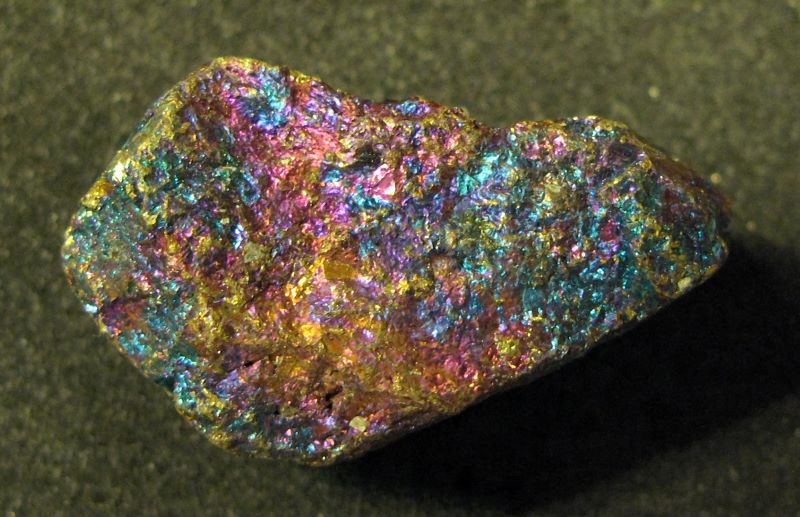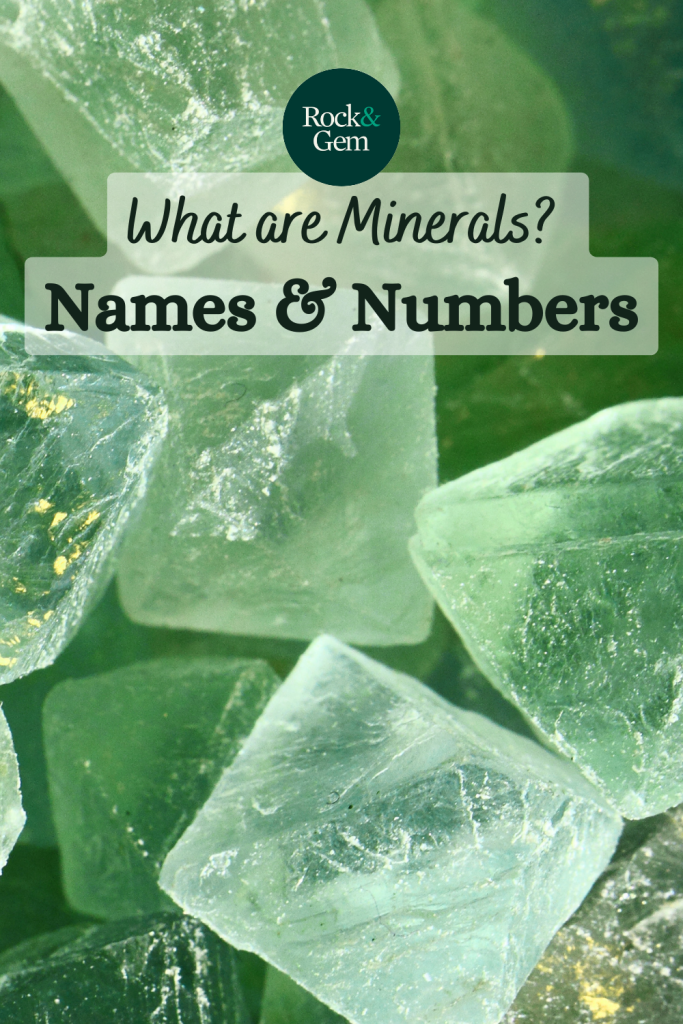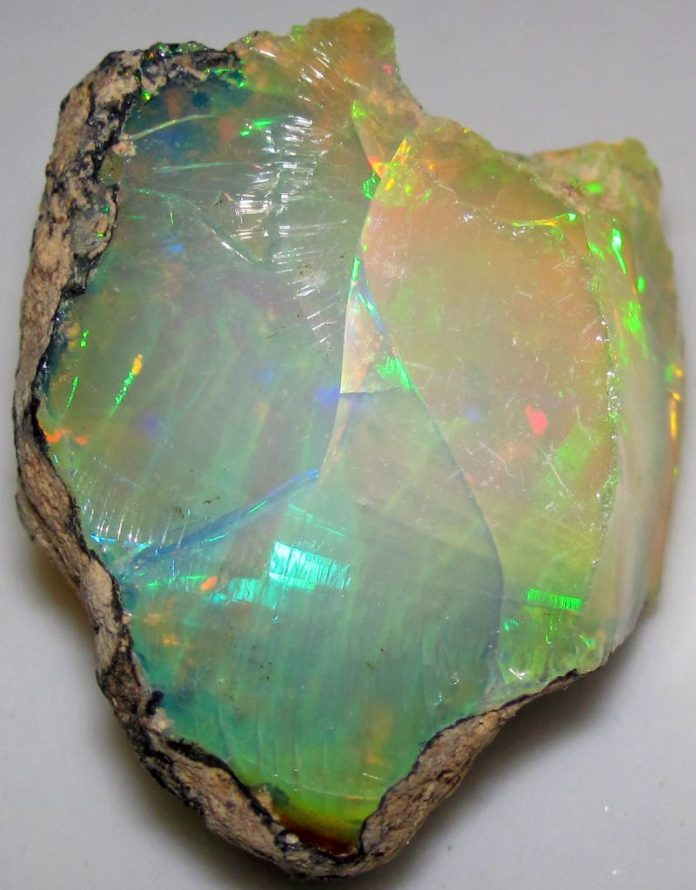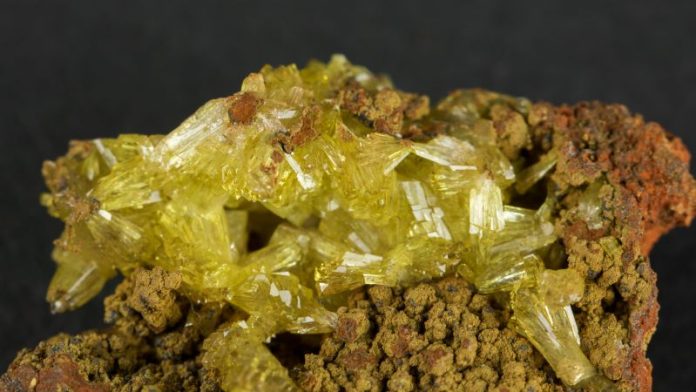What are Minerals? Names & Numbers
By Admin - March 18, 2024

Chalcopyrite is one of a dozen copperbearing minerals with names beginning with the prefix “chalco-“, from the Greek chalkos, meaning “copper.” (Wikimedia Commons)
"What are minerals? A few hours at a mineralogical museum or a rock and gem show will make it clear there are lots of different minerals. But exactly how many can be surprising. As of September 2023, the International Mineralogical Association’s official tally of mineral species stood at a whopping 5,975…and counting.
During the two millennia that preceded the mid-18th century, naturalists, scholars, miners, alchemists, and early scientists had recognized only about 200 clearly differentiated mineral species—an average discovery rate of roughly one new mineral every ten years. But with today’s rapid growth in mineralogical research backed by increasingly sophisticated analytical tools, mineralogists are discovering and naming new minerals at the rate of nine every month. By the time this article is published, the official count of mineral species will have surpassed 6,000—with more than half described in just the past 50 years.

Pin this post to save this information for later.
What are Minerals? In the Beginning
The current system of describing and naming minerals evolved over three general periods: antiquity to 1750; 1751 to 1957; and 1958 to the present. Before 1750, knowledge of what are minerals was limited to common types with distinctive properties or those with substantial economic, medicinal, or metallurgical value, all obtained from surface or shallow mineralogical environments. Their names were derived from ancient Greek or Latin words, mining terms, and the whims of individual scholars.
In the mid-1700s, knowledge of chemistry, physics, and crystallography was rudimentary and mineralogy did not yet exist. With limited communication between researchers, the naming of new minerals was a confusing practice replete with errors and repetitions.
Minerals often had multiple names, with many referring not to species, but to varieties of species. Names and their spellings, which varied radically among regions, languages, and cultures, were considered “formalized” if they appeared in scholarly works or simply became popular in general use.

Marie Sklodowska Curie, discoverer of radium and recipient of two Nobel Prizes, is one of only 30 individuals with two minerals named in their honor.
(Wikimedia Commons)
Mixing Tradition & Science
As science displaced alchemy in the late 1700s, researchers began discovering many new elements and the emerging subsciences of analytical chemistry and crystallography provided a basis for the preliminary classification of minerals. The rate of mineral discovery increased markedly, yet the naming of new minerals remained an awkward mix of enduring tradition and advancing science. What are minerals often was defined by their chemical compositions, physical properties, or major occurrences, with many names stemming from Greek or Latin words.
A different trend started in 1789 when prehnite (basic calcium aluminum silicate) was named for Hendrick von Prehn, governor of the then-Dutch colony of South Africa. Naming minerals for individuals then quickly became popular. In 1810, as one example, cordierite (magnesium iron aluminum silicate), known for its blue iolite gem variety, was named after French mineralogist Louis Cordier, a pioneer in microscopic mineralogy. In 1823, goethite (basic iron oxide) was named for German poet and philosopher Johann Wolfgang von Goethe.
The basis of mineral names broadened to include mythological figures when aegerine (sodium iron silicate) was named after Ægir, the ancient Norse god of the sea, and neptunite (a complex multimetal silicate) took its name from Neptune, the Roman god of the sea. Traditionally, the discoverer of a new mineral chose its name.
Science Takes Over
In 1840, when 350 minerals had been described, American mineralogist James Dwight Dana published his landmark System of Mineralogy which classified minerals by chemistry and crystallography, and did much to formalize mineral names and standardize their spellings. In 1866, Dana was himself honored with a new mineral name—danalite, an iron beryllium sulfosilicate.
By that time, mineralogists had begun correcting the plethora of early naming errors and inconsistencies. However, most still worked independently and were unaware of the efforts of their peers. So when they identified the same new mineral, they almost always named it differently.
In 1875, mineralogists agreed that all new mineral names would end in “ite,” a suffix derived from the Greek lithos, meaning “stone.” This idea was not entirely original. Some minerals, such as hematite (iron oxide), had been named centuries earlier and already had the “ite” suffix.
Mineralogists also moved to eliminate duplication by conserving type specimens— the original specimens from which new minerals were described. Conserving type specimens in university and museum repositories made them available for both direct comparison with proposed new minerals and for later study should the validity of a mineral’s status be questioned.
By the early 1900s when the introduction of X-ray-diffraction techniques greatly facilitated the discovery of new minerals, more than 1,000 species had been recognized. Another big step was formalizing the definition of what are minerals — solid, naturally occurring, inorganic materials with an orderly, crystalline structure and a more-or-less definite chemical composition.

Although opal is technically a mineraloid, the IMA lists it as a mineral in a nod to history and tradition.
(Wikimedia Commons)
Modern Science & The International Mineralogical Association
By the time mineralogists had described the 2,000th mineral in the late 1950s, the lack of a central organization to approve, document, and name new discoveries had become all too apparent. A study showed that one-third of the 583 new minerals described in various journals since 1940 were identical to, or varieties of, existing minerals. Compounding the problem was that the 2,000 recognized minerals had nearly 20,000 names in use in various nations and different languages around the world.
In 1956, the British Mineralogical Society proposed establishing an organization of national mineralogical societies to further international cooperation in mineralogical research and standardize what are minerals and their mineral nomenclature. In 1958, the mineralogical societies of 16 nations formed the International Mineralogical Association (IMA). Its first order of business was to appoint a committee that is now the Commission on New Minerals, Nomenclature and Classification (CNMNC). This marked the beginning of the modern era of describing and naming minerals.
The original IMA committee devised a standard review system to approve proposed new minerals and existing minerals of questionable validity. It also “grandfathered” 1,289 previously named minerals, some dating to antiquity. These included such familiar species as quartz, gold, silver, malachite, and galena, which were accepted without undergoing the now-standard review process. The CNMNC also addressed the issue of minerals with multiple names, such as calcium titanium oxysilicate, previously known as both “titanite” and “sphene.” Even though “sphene” was most widely used, the committee validated only the original “titanite.”
_______________________________________________________________________________________________
Naming Minerals Today
Anyone—rockhounds as well as scientists—who believes they have discovered a new mineral and can provide supporting chemical and physical data must submit proposals to the IMA’s CNMNC, which determines the validity of the new mineral. Until the proposed mineral is approved or rejected, it is identified only by a number.
The IMA, with a current membership of 39 national mineralogical societies, prohibits new mineral discoverers from publishing descriptions until the CNMNC has confirmed the validity of the proposed new mineral. This keeps names out of print until it is certain that they do not duplicate those of existing minerals.
After approving a new species, the CNMNC invites its discoverer to suggest a name. This proposed name must have the “-ite” suffix and be based on chemical composition, physical properties, chemical or crystallographic relationships to previously named species, type localities, or deserving persons, the latter ideally honoring those who have contributed significantly to mineralogy or its many related fields.
________________________________________________________________________________________________
Honoring People
Half of today’s 6,000 mineral names honor individuals, mostly scientists. Examples familiar to collectors are scheelite (calcium tungstate), named for Swedish chemist Carl Wilhelm Scheele; bornite (copper iron sulfide), after Hungarian mineralogist Ignaz von Born; and adamite (basic zinc arsenate), for French researcher and mineral collector Gilbert-Joseph Adam. Notable exceptions to the “scientist” names are mozartite (basic calcium manganese silicate), named for Austrian-born German composer Wolfgang Amadeus Mozart, and the garnet-group member uvarovite, which honors 19th-century Russian statesman Sergey Uvarov.
Names citing contributors to mineral collecting and general mineralogical education include wendwilsonite (hydrous calcium magnesium arsenate), honoring Wendell Wilson, editor and publisher of The Mineralogical Record; and bobjonesite (hydrous vanadium oxysulfate), which honors author, lecturer, and Rock & Gem editor emeritus Bob Jones (whose monthly column appears in this issue).
Only 93 mineral names honor women. When ranked by their scientific achievements the foremost among them is Polish-born French researcher Marie Sklodowska-Curie who, in the early 20th century, discovered radium and earned two Nobel Prizes.
Sklodowska-Curie is remembered in the mineral names sklodowskite (hydrous magnesium uranyl silicate) and curite (hydrous lead uranyl oxide), the latter honor shared with her husband, French physicist Pierre Curie. Sklodowska-Curie is one of only 30 individuals to have two minerals named in their honor.
Another double honoree is NASA astronaut Neil Armstrong, the first person to walk on the moon. The Armstrong-named minerals, both identified from lunar specimens, are armstrongite (hydrous calcium zirconium silicate) and armalcolite (magnesium iron titanate), the latter jointly named for ARMstrong and his Apollo 11 crewmembers Edwin E. “Buzz” ALdrin and Michael COLlins.

The mineral adamite is named for French researcher and mineral collector Gilbert-Joseph Adam.
(Wikimedia Commons)
. . . And Places and Properties
About one-quarter of all minerals are named for places. Two classic mineral localities are reflected in the names ojuelaite (hydrous zinc iron arsenate), which cites Mexico’s historic Ojuela Mine, and tsumebite, after Namibia’s Tsumeb Mine. Other place-based names include aragonite (calcium carbonate, orthorhombic), from Aragon, Spain; and the gemstone brazilianite (basic sodium aluminum phosphate), after Brazil. And contrary to popular belief, magnetite (ferrous-ferric oxide) is not named for its magnetic properties, but for Magnesia, the region in ancient Greece where it was discovered.
About 14 percent of all mineral names reflect chemical compositions. Among them are vanadinite (lead chlorovanadate), named for the element vanadium; and stibnite (antimony trisulfide), after stibium, the Greek word for antimony. And the names of a dozen copper-bearing minerals begin with the prefix “chalco-“, from the Greek chalkos, meaning “copper.”
Eight percent of mineral names stem from physical properties, among them azurite (basic copper carbonate), for its azure color, and the dense mineral barite (barium sulfate), from the Greek barytēs or “weight.”
What are Minerals: Oddities
Despite the IMA’s current naming protocols, its list of what are minerals minerals retains some oddities and exceptions. The names of most “grandfathered” minerals lack the modern “ite” suffix. Familiar examples are cinnabar (mercury sulfide), from the Arabic zingafr; galena (lead sulfide), from galene, the Greek term for lead ore; and quartz (silicon dioxide), from the German Quarz.
Another is spodumene (lithium aluminum silicate), named in 1800 after the Greek spodoumenos meaning “burnt to ashes” for its ash-like color when crushed. Although spodumene does not have the “-ite” suffix, its gem varieties do: lilac kunzite is named after America’s pioneer gemologist George Frederick Kunz, while green hiddenite honors American geologist William Earl Hidden. A similar anomaly is selenite, the crystalline variety of gypsum (hydrous calcium sulfate), which ends in “-ite,” yet the parent-mineral name does not.
Not all IMA-approved species even meet the technical definition of what are minerals. Nevertheless, in a nod to history and tradition, the IMA list includes mercury, a liquid at ambient temperatures and thus lacking a crystalline structure and opal, an amorphous, hydrous silicon dioxide of variable composition.
But, given the long history, rich traditions, and technical complexity of minerals, a list of 6,000-plus species can be expected to have ... "
https://www.rockngem.com/what-are-miner ... ch_21_2024